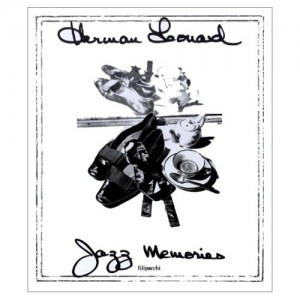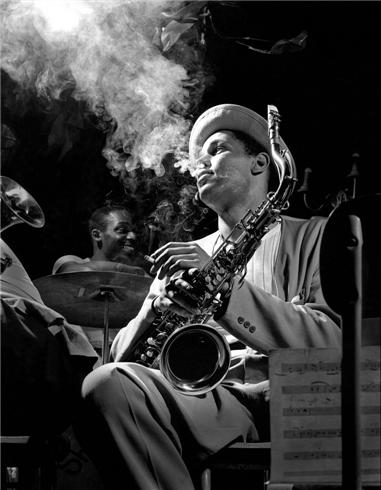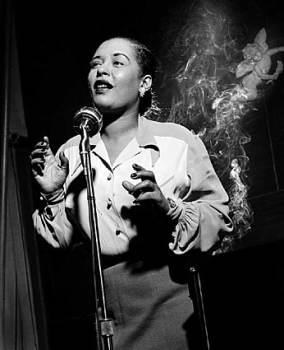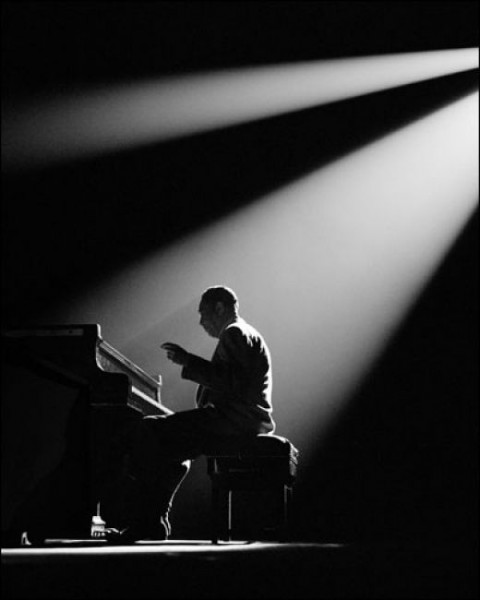Master Jazz Photographer Herman Leonard Takes the ‘A’ Train
One of the great jazz photographers of all time, Herman Leonard, passed away on August 14th, 2010. Govinda Gallery had the great honor of presenting an exhibition of Herman Leonard’s photographs in the fall of 1996, and enjoyed a warm friendship with Herman Leonard since that time. Leonard’s images of jazz musicians, singers, composers, and arrangers are among the best jazz photographs ever taken. Along with William Gottlieb and William Claxton, Herman Leonard’s photographs have come to define the visual imagery of jazz music.
Leonard attended his opening at Govinda Gallery in 1996, traveling to Washington from his home in New Orleans. Leonard’s book Jazz Memories was available at the gallery during the opening, and he happily signed every copy in stock.
 The cover of Herman Leonard’s book Jazz Memories. Copyright © Filipacchi Editions. All Rights Reserved.
The cover of Herman Leonard’s book Jazz Memories. Copyright © Filipacchi Editions. All Rights Reserved.
There was a great after party for Leonard at Carol Gray’s home in Georgetown. The lively evening ended with an arm-wrestling contest, the final round pairing collector and decorator Carol Gray against artist Carlotta Hester. Hester was declared the winner, with Herman Leonard as the judge.
Richard Harrington’s feature story in The Washington Post (September 11th, 1996) about Herman Leonard and his exhibition at Govinda is a great summary of the photographer’s life and work. We present Harrington’s story for you here in The Back Room.
On The Beat
Box of Negatives Is a Positive Jazz Treasure
Wednesday, September 11, 1996
By Richard Harrington
Washington Post Staff Writer
People don’t always realize when they’ve been in the middle of a historical moment. For photographer Herman Leonard, it took almost 30 years to reconnect to a key period in jazz history, one he had actually captured on film- and then forgotten.
“Does one ever know?” Leonard asked recently from New Orleans, where he has been working on a book about the birthplace of jazz. Forty years earlier, Leonard was in another city, New York, just as it was birthing a new form of jazz called bebop, carrying a heavy Speed Graphic to clubs in Harlem and on 52nd Street while capturing images of young adventurers named Parker, Gillespie, Blakey and Monk.
 Saxaphonist Dexter Gordon in 1948 at New York City’s Royal Roost. Copyright © Herman Leonard. All Rights Reserved.
Saxaphonist Dexter Gordon in 1948 at New York City’s Royal Roost. Copyright © Herman Leonard. All Rights Reserved.
“I was just having a ball,” Leonard notes. “I loved what I was listening to, and I used the camera to get in free and photograph people I liked. By coincidence, it happened to be around the time Dizzy Gillespie, and Charlie Parker brought about the bebop movement, but I didn’t know they would turn things around musically.”
“When I was photographing Monk and Parker and these other innovators, I had no idea that later on they’d be looked back upon as being icons. Had I known, my God, I would have shot a hell of a lot more pictures!”
“Photography You Can Hear,” featuring the work of Herman Leonard, opens tomorrow at Georgetown’s Govinda Gallery (Herman Leonard will be on hand for the opening). What’s remarkable about the show is that for 30 years, Leonard’s classic black-and-white images of the bebop generation, as well as portraits of older giants like Duke Ellington, Ella Fitzgerald, Art Tatum and Louis Armstrong, sat undisturbed beneath a bed in a box that was at various times in the South Pacific, France, Spain and England.
Leonard, who shot his jazz subjects from 1947 to 1960, made his living as a commercial photographer in the fashion and advertising industries. Once in a while, he says, a jazz magazine might purchase a picture “to accompany some article if they knew I had a shot of some particular musician. But at that point, Down Beat [the leading jazz magazine] was paying 10 dollars per photo. There was no living off of that, so I had to do other things.”
When he’d first gone to Ohio University in Athens in 1940, Leonard recalls, “I was an aspiring young actor,” and working in theater may have been the inspiration for his distinctive portrait style- Leonard’s photos are often back-lit, full of swirling smoke and other evocative detail. “I spent a lot of time backstage looking at the audience, and from there practically everything is back-lit. I noticed that when figures moved across the stage lit the way they were, they stood out sharply against the dark back- ground of the audience. I was always impressed with the graphic imagery of that particular kind of lighting.”
In fact, while that technique would give Leonard’s photos their emotional power, he started using it by accident: When a big band came to Ohio University, Leonard asked trumpeter Ray Wetzel to pose for a portrait. “One of the front lights didn’t fire and I had only the back light- but I got exactly what I’d seen from backstage. I said, “That’s it, that’s the feeling I’m looking for.”
However, Leonard’s breakthrough was interrupted by World War II, as he was drafted and sent to the South Pacific. After returning to Ohio and graduating in 1947 with a fine-arts degree in photography, Leonard had an apprenticeship with Yousuf Karsh, considered by many the greatest portrait photographer of this century.
“I loaded the film, went to sessions, adjusted the light according to his direction,” Leonard recalls with unmistakable warmth and respect. “Anybody spending time with that man, watching him work with the people that he photographed, cannot help but be influenced. Talk about diplomacy and flexibility in dealing with the person in front of you- he should have been the president of the world!”
 Lady Day at Night: Herman Leonard’s 1949 portrait of singer Billie Holiday in New York City. Copyright © Herman Leonard. All Rights Reserved.
Lady Day at Night: Herman Leonard’s 1949 portrait of singer Billie Holiday in New York City. Copyright © Herman Leonard. All Rights Reserved.
Unlike the elaborate and “informal” formality of Karsh portraiture, Leonard’s photos are defined more by action. For instance, his classic image of Art Blakey, shot in 1958, captures not only the drummer’s aura of perpetually energized motion but also the ecstatic spirituality at the core of his music. Because there were no editorial expectations or constraints- Leonard’s pictures were a private pleasure – there was no subtle positioning or direction.
 Duke Ellington, Paris 1958. Copyright © Herman Leonard. All Rights Reserved.
Duke Ellington, Paris 1958. Copyright © Herman Leonard. All Rights Reserved.
“I never told a musician to turn to the right or left, I simply waited,” Leonard says. “I did not want to alter the feeling, the mood, or the attitude of what I was photographing.”
In 1956, Leonard went to work as Marlon Brando’s personal photographer as the actor was looking to set up a film company in the South Pacific. This was long before shooting Brando would require a wide-angle lens- “he was slim and slender and beautiful then,” Leonard points out- but nothing ever came of the film company. Later that year, Leonard moved to Paris, working first for a major French record label and subsequently in fashion and advertising. By 1960, he’d stopped photographing the jazz men and women who came to Paris “because I didn’t have the time.”
Leonard didn’t even keep any prints- the jazz-era negatives were stuffed in a box and kept under his bed, where they languished until 1987. By that time, Leonard and his family had moved to the Spanish island of Ibiza and finally to London.
“I had no sense of what they meant,” he admits. “In fact, because I’d shot them for myself personally, I didn’t think they had any commercial or retail value of any kind. Nor did I attach much historical value to them because I knew there were others around who had photographed the same people.”
When Leonard pulled the well-traveled box out from under the bed, he was, he says, in a state of total depression. “I was flat broke, with a family on my hands, and here’s a bunch of old negatives, misfiled, with no prints.” Leonard then experienced another setback. “I was turned down by all the best galleries in London, and then picked up by a very little one in Portobello Road. And from there on, it was a different story.”
Leonard’s first show, in 1988, was widely heralded by critics, and the exhibition was attended by more than 10,000 people. For Leonard, the only disappointment was learning that somewhere along the line, he’d lost almost 50 percent of his treasure trove (he kept finding old contact sheets for which no negatives existed, including pictures of Frank Sinatra, Cannonball Adderley and Thelonious Monk.) “I have very few of Monk,” Leonard says regretfully, “but I’ve got what I’ve got and I’m grateful for it.”
So are jazz fans.
Stunning photographs Chris. You have a way of finding the very best of artists with your special talent. You must feel so good to have honoured Leonard with an exhibition of his brilliant photographs.
Well done. And reading the arm wrestling match with Carlotta as winner put a smile on my face.